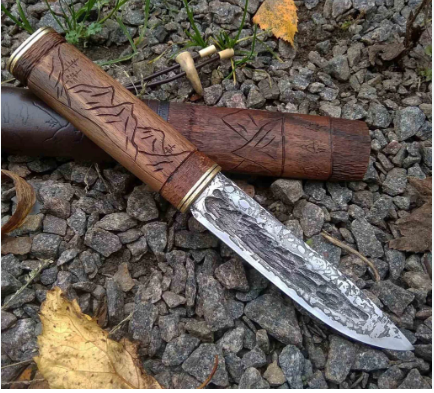Yakut Knife vs. Seax Knife: A Comparative Guide

Introduction
The Yakut knife and the seax knife are two distinct blades with rich histories and cultural significance. Originating from different regions and serving various purposes, these knives are distinguished by their design, construction, and usage. This article explores the differences between the Yakut knife and the seax knife, highlighting their unique characteristics and cultural contexts.
Yakut Knife
Origin and History
The Yakut knife, also known as "Yakutskaya Nozh," originates from the Sakha (Yakutia) Republic in Siberia, Russia. It has been an essential tool for the Yakut people for centuries, used for hunting, fishing, and everyday tasks in the harsh Siberian environment.
Design and Features
1. Blade Shape: The Yakut knifes features a distinctive asymmetric blade. One side of the blade is flat, while the other side is convex. This design provides excellent control and precision, making it ideal for tasks that require fine cutting and carving.
2. Blade Material: Traditional Yakut knives are made from high-carbon steel, which holds a sharp edge and is easy to sharpen. Modern versions may use various steels, including stainless steel, for improved corrosion resistance.
3. Handle: The handle of a Yakut knife is typically made from birch or other local woods, sometimes combined with bone or antler. It has an ergonomic shape that fits comfortably in the hand, providing a secure grip even in cold and wet conditions.
4. Tang: Yakut knives often have a hidden tang, where the blade extends into the handle but is not visible. This construction ensures durability and balance.
5. Sheath: The sheath is usually made from wood or leather, designed to protect the blade and provide easy access.
Usage
The Yakut knife for sale is versatile and used for a variety of tasks, including:
- Skinning and butchering game
- Carving wood and bone
- Preparing fish
- Everyday cutting tasks
Its design is particularly well-suited for the cold Siberian climate, allowing for precise and efficient cutting even in challenging conditions.
Seax Knife
Origin and History
The seax knife, also known simply as "seax" or "sax," has its origins in early medieval Europe, particularly among the Anglo-Saxons, Vikings, and other Germanic tribes. It was widely used from the Migration Period through the Viking Age (circa 5th to 11th centuries AD).
Design and Features
1. Blade Shape: The seax knife features a straight or slightly curved single-edged blade with a characteristic broken back or clipped point. This design provides a strong, durable blade capable of both cutting and stabbing.
2. Blade Material: Historical seax blades were typically made from pattern-welded steel, combining iron and steel to create a tough, resilient blade. Modern replicas use various steels, including high-carbon and stainless steel.
3. Handle: The handle of a seax is usually straight and can be made from wood, bone, or horn. It often lacks the pronounced ergonomic shaping found in Yakut knives, reflecting its utilitarian purpose.
4. Tang: Seaxes often feature a full tang, where the blade extends the entire length of the handle, providing strength and balance.
5. Sheath: The sheath is typically made from leather and may include decorative elements such as carvings or metal fittings.
Usage
The seax was a multipurpose tool and weapon used for:
- Combat and self-defense
- Crafting and woodworking
- Hunting and butchering game
- General everyday tasks
The robust design made the seax an essential item for survival and combat, favored by warriors and civilians alike.
Conclusion
While both the Yakut knife and the seax knife are historically significant and practical tools, they differ in design, construction, and cultural context. The Yakut knife, with its asymmetric blade and ergonomic handle, is tailored for precision tasks in harsh Siberian conditions. In contrast, the seax knife, with its robust, straight-edged blade, served as a versatile tool and weapon among early medieval European cultures. Understanding these differences highlights the unique craftsmanship and cultural heritage behind each blade, offering valuable insights into their respective histories and uses.
- Industry
- Art
- Causes
- Crafts
- Dance
- Drinks
- Film
- Fitness
- Food
- Games
- Gardening
- Health
- Home
- Literature
- Music
- Networking
- Other
- Party
- Religion
- Shopping
- Sports
- Theater
- Wellness
- News


